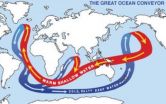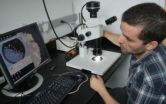(Press-News.org) Climate scientists have long tried to explain why ice-age cycles became longer and more intense some 900,000 years ago, switching from 41,000-year cycles to 100,000-year cycles.
In a paper published this week in the journal Science, researchers report that the deep ocean currents that move heat around the globe stalled or may have stopped at that time, possibly due to expanding ice cover in the Northern Hemisphere.
"The research is a breakthrough in understanding a major change in the rhythm of Earth's climate, and shows that the ocean played a central role," says Candace Major, program director in the National Science Foundation (NSF)'s Division of Ocean Sciences, which funded the research.
The slowing currents increased carbon dioxide (CO2) storage in the oceans, leaving less CO2 in the atmosphere. That kept temperatures cold and kicked the climate system into a new phase of colder, but less frequent, ice ages, the scientists believe.
"The oceans started storing more carbon dioxide for a longer period of time," says Leopoldo Pena, the paper's lead author and a paleoceanographer at Columbia University's Lamont-Doherty Earth Observatory (LDEO). "Our evidence shows that the oceans played a major role in slowing the pace of the ice ages and making them more severe."
The researchers reconstructed the past strength of Earth's system of ocean currents by sampling deep-sea sediments off the coast of South Africa, where powerful currents originating in the North Atlantic Ocean pass on their way to Antarctica.
How vigorously those currents moved can be inferred by how much North Atlantic water made it that far, as measured by isotope ratios of the element neodymium bearing the signature of North Atlantic seawater.
Like tape recorders, the shells of ancient plankton incorporate these seawater signals through time, allowing scientists to approximate when currents grew stronger and when weaker.
Over the last 1.2 million years, the conveyor-like currents strengthened during warm periods and lessened during ice ages, as previously thought.
But at about 950,000 years ago, ocean circulation slowed significantly and stayed weak for 100,000 years.
During that period the planet skipped an interglacial--the warm interval between ice ages. When the system recovered, it entered a new phase of longer, 100,000-year ice age cycles.
After this turning point, deep ocean currents remained weak during ice ages, and ice ages themselves became colder.
"Our discovery of such a major breakdown in the ocean circulation system was a big surprise," said paper co-author Steven Goldstein, a geochemist at LDEO. "It allowed the ice sheets to grow when they should have melted, triggering the first 100,000-year cycle."
Ice ages come and go at predictable intervals based on the changing amount of sunlight that falls on the planet, due to variations in Earth's orbit around the sun.
Orbital changes alone, however, are not enough to explain the sudden switch to longer ice age intervals.
According to one earlier hypothesis for the transition, advancing glaciers in North America stripped away soils in Canada, causing thicker, longer-lasting ice to build up on the remaining bedrock.
Building on that idea, the researchers believe that the advancing ice might have triggered the slowdown in deep ocean currents, leading the oceans to vent less carbon dioxide, which suppressed the interglacial that should have followed.
"The ice sheets must have reached a critical state that switched the ocean circulation system into a weaker mode," said Goldstein.
Neodymium, a key component of cellphones, headphones, computers and wind turbines, also offers a good way of measuring the vigor of ancient ocean currents.
Goldstein and colleagues had used neodymium ratios in deep-sea sediment samples to show that ocean circulation slowed during past ice ages.
They used the same method to show that changes in climate preceded changes in ocean circulation.
A trace element in Earth's crust, neodymium washes into the oceans through erosion from the continents, where natural radioactive decay leaves a signature unique to the land mass from which it originated.
When Goldstein and Lamont colleague Sidney Hemming pioneered this method in the late 1990s, they rarely worried about surrounding neodymium contaminating their samples.
The rise of consumer electronics has changed that.
"I used to say you could do sample processing for neodymium analysis in a parking lot," said Goldstein. "Not anymore."
INFORMATION:
Ancient ocean currents may have changed pace and intensity of ice ages
Slowing of currents may have flipped switch
2014-06-27
ELSE PRESS RELEASES FROM THIS DATE:
Research gives unprecedented 3-D view of important brain receptor
2014-06-27
PORTLAND, Ore. — Researchers with Oregon Health & Science University's Vollum Institute have given science a new and unprecedented 3-D view of one of the most important receptors in the brain — a receptor that allows us to learn and remember, and whose dysfunction is involved in a wide range of neurological diseases and conditions, including Alzheimer's, Parkinson's, schizophrenia and depression.
The unprecedented view provided by the OHSU research, published online June 22 in the journal Nature, gives scientists new insight into how the receptor — called the NMDA receptor ...
Study: To address climate change, nothing substitutes for reducing CO2 emissions
2014-06-27
The politically expedient way to mitigate climate change is essentially no way at all, according to a comprehensive new study by University of Chicago climatologist Raymond Pierrehumbert.
Among the climate pollutants humans put into the atmosphere in significant quantities, the effects of carbon dioxide (CO2) are the longest-lived, with effects on climate that extend thousands of years after emissions cease. But finding the political consensus to act on reducing CO2 emissions has been nearly impossible. So there has been a movement to make up for that inaction by reducing ...
Some aggressive cancers may respond to anti-inflammatory drugs
2014-06-27
New research raises the prospect that some cancer patients with aggressive tumors may benefit from a class of anti-inflammatory drugs used to treat rheumatoid arthritis.
Studying triple-negative breast cancer, researchers at Washington University School of Medicine in St. Louis found that some aggressive tumors rely on an antiviral pathway that appears to drive inflammation, widely recognized for roles in cancer, rheumatoid arthritis and other inflammatory diseases.
The tumors that activate this particular antiviral pathway always have dysfunctional forms of the proteins ...
Diamond plates create nanostructures through pressure, not chemistry
2014-06-27
ALBUQUERQUE, N.M. — You wouldn't think that mechanical force — the simple kind used to eject unruly patrons from bars, shoe a horse or emboss the raised numerals on credit cards — could process nanoparticles more subtly than the most advanced chemistry.
Yet, in a current paper in Nature Communications, Sandia National Laboratories researcher Hongyou Fan and colleagues appear to have achieved a start toward that end.
Their newly patented and original method uses simple pressure — a kind of high-tech embossing — to produce finer and cleaner results in forming silver ...
Research may yield new ways to treat antibiotic-resistant TB
2014-06-27
CORVALLIS, Ore. – Scientists in the United States and India have successfully modified the precursor to one of the drugs used to treat tuberculosis, an important first step toward new drugs that can transcend antibiotic resistance issues that experts consider a serious threat to global health.
The findings, reported in the Journal of Biological Chemistry, indicate that a new compound, 24-desmethylrifampicin, has much better antibacterial activity than rifampicin against multi-drug-resistant strains of the bacteria that cause tuberculosis.
Rifampicin and related drugs ...
Youth regularly receive pro-marijuana tweets
2014-06-27
AUDIO:
Twitter has become one of the most popular social media sites among young people, and researchers at Washington University School of Medicine in St. Louis have been looking at Twitter....
Click here for more information.
Hundreds of thousands of American youth are following marijuana-related Twitter accounts and getting pro-pot messages several times each day, researchers at Washington University School of Medicine in St. Louis have found.
The tweets are cause for ...
A new species of moth from the Appalachian Mountains named to honor the Cherokee Nation
2014-06-27
A small, drab and highly inconspicuous moth has been flitting nameless about its special niche among the middle elevations of one of the world's oldest mountain ranges, the southern Appalachian Mountains in North America. A team of American scientists has now identified this new to science species as Cherokeea attakullakulla and described it in a special issue of the open access journal ZooKeys.
In all probability, it has been frequenting these haunts for tens of millions of years before the first humans set foot on this continent, all the while not caring in the least ...
Kids who know unhealthy food logos more likely to be overweight
2014-06-27
The more a child is familiar with logos and other images from fast-food restaurants, sodas and not-so-healthy snack food brands, the more likely the child is to be overweight or obese.
And, unfortunately, studies have shown that people who are overweight at a young age, tend to stay that way.
A research team that included a Michigan State University professor tested kids on their knowledge of various brands – including their ability to identify items such as golden arches, silly rabbits and a king's crown – and found that those who could identify them the most tended ...
'Compressive sensing' provides new approach to measuring a quantum system
2014-06-27
In quantum physics, momentum and position are an example of conjugate variables. This means they are connected by Heisenberg's Uncertainty Principle, which says that both quantities cannot be simultaneously measured precisely. Recently, researchers have been developing novel techniques, such as "weak measurement," to measure both at the same time. Now University of Rochester physicists have shown that a technique called compressive sensing also offers a way to measure both variables at the same time, without violating the Uncertainty Principle.
In a paper published in ...
Developmental psychologist explains her life's work studying the mysteries of the mind
2014-06-27
HAMILTON, ON, June 27, 2014—Developmental psychologist Daphne Maurer has spent more than four decades studying the complexities of the human mind.
As the director of the Visual Development Lab at McMaster University and president of the International Society on Infant Studies, Maurer will present her life's work at the Biennial International Conference on Infant Studies in Berlin July 4th.
Over the course of her career she has established a reputation for building new understanding of one of the most challenging and mysterious aspects of human development: how our ...
LAST 30 PRESS RELEASES:
Making lighter work of calculating fluid and heat flow
Normalizing blood sugar can halve heart attack risk
Lowering blood sugar cuts heart attack risk in people with prediabetes
Study links genetic variants to risk of blinding eye disease in premature infants
Non-opioid ‘pain sponge’ therapy halts cartilage degeneration and relieves chronic pain
AI can pick up cultural values by mimicking how kids learn
China’s ecological redlines offer fast track to 30 x 30 global conservation goal
Invisible indoor threats: emerging household contaminants and their growing risks to human health
Adding antibody treatment to chemo boosts outcomes for children with rare cancer
Germline pathogenic variants among women without a history of breast cancer
Tanning beds triple melanoma risk, potentially causing broad DNA damage
Unique bond identified as key to viral infection speed
Indoor tanning makes youthful skin much older on a genetic level
Mouse model sheds new light on the causes and potential solutions to human GI problems linked to muscular dystrophy
The Journal of Nuclear Medicine ahead-of-print tip sheet: December 12, 2025
Smarter tools for peering into the microscopic world
Applications open for funding to conduct research in the Kinsey Institute archives
Global measure underestimates the severity of food insecurity
Child survivors of critical illness are missing out on timely follow up care
Risk-based vs annual breast cancer screening / the WISDOM randomized clinical trial
University of Toronto launches Electric Vehicle Innovation Ontario to accelerate advanced EV technologies and build Canada’s innovation advantage
Early relapse predicts poor outcomes in aggressive blood cancer
American College of Lifestyle Medicine applauds two CMS models aligned with lifestyle medicine practice and reimbursement
Clinical trial finds cannabis use not a barrier to quitting nicotine vaping
Supplemental nutrition assistance program policies and food insecurity
Switching immune cells to “night mode” could limit damage after a heart attack, study suggests
URI-based Global RIghts Project report spotlights continued troubling trends in worldwide inhumane treatment
Neutrophils are less aggressive at night, explaining why nighttime heart attacks cause less damage than daytime events
Menopausal hormone therapy may not pose breast cancer risk for women with BRCA mutations
Mobile health tool may improve quality of life for adolescent and young adult breast cancer survivors
[Press-News.org] Ancient ocean currents may have changed pace and intensity of ice agesSlowing of currents may have flipped switch








